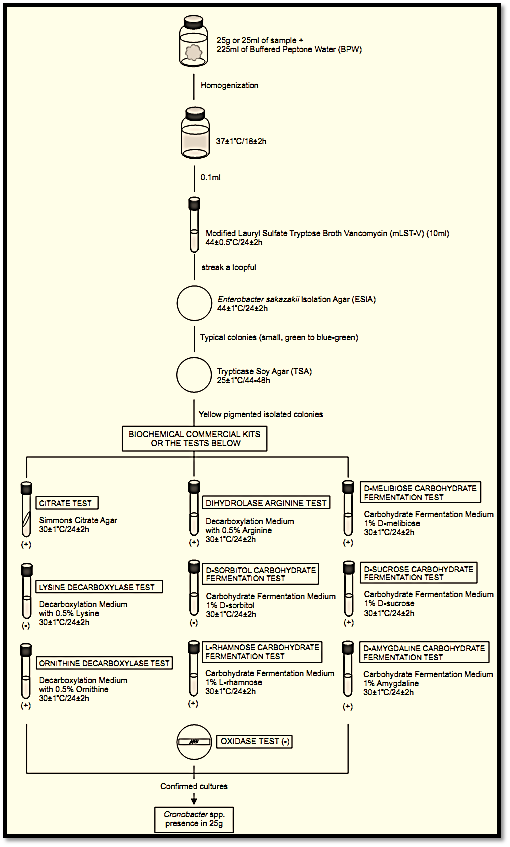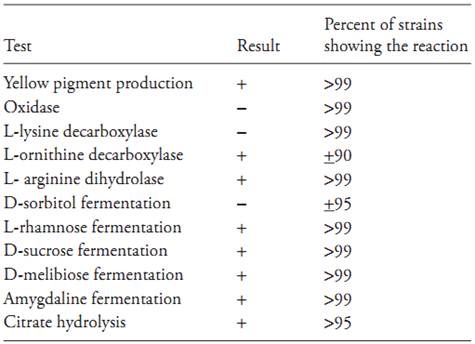


 النبات
النبات
 الحيوان
الحيوان
 الأحياء المجهرية
الأحياء المجهرية
 علم الأمراض
علم الأمراض
 التقانة الإحيائية
التقانة الإحيائية
 التقنية الحيوية المكروبية
التقنية الحيوية المكروبية
 التقنية الحياتية النانوية
التقنية الحياتية النانوية
 علم الأجنة
علم الأجنة
 الأحياء الجزيئي
الأحياء الجزيئي
 علم وظائف الأعضاء
علم وظائف الأعضاء
 الغدد
الغدد
 المضادات الحيوية
المضادات الحيوية| Presence/absence method ISO 22964:2006 for Cronobacter [ Enterobacter sakazakii] in milk powder and powdered infant formula |
|
|
|
Read More
Date: 14-3-2016
Date: 13-3-2016
Date: 20-3-2016
|
Presence/absence method ISO 22964:2006 for Cronobacter [ Enterobacter sakazakii] in milk powder and powdered infant formula
This method is applicable to milk powder, powdered infant formula, and environmental samples collected from milk powder or infant formula factories. It will not recover non yellow-pigmented strains of Cronobacter spp.
1 . Material required for analysis
• Buffered Peptone Water (BPW)
• Modified Lauryl Sulfate Tryptose Broth Vancomycin (mLSTV)
• Enterobacter sakazakii Isolation Agar (ESIA) plates
• Trypticase Soy Agar (TSA) plates
• Oxidase Kovacs Reagent
• Miniaturized biochemical identification kits or bio-chemical tests media below:
• Decarboxylation Medium 0.5% L-Lysine
• Decarboxylation Medium 0.5% L-Ornithine
• Decarboxylation Medium 0.5% L-Arginine
• Carbohydrate Fermentation Medium 1% D-sorbitol
• Carbohydrate Fermentation Medium 1% L-rhamnose
• Carbohydrate Fermentation Medium 1% D-sucrose
• Carbohydrate Fermentation Medium 1% D-melibiose
• Carbohydrate Fermentation Medium 1% amygdaline
• Simmons Citrate Agar
• Laboratory incubator or water bath set to 44 ± 0.5°C
• Laboratory incubator set to 44 ± 1°C
• Laboratory incubator set to 37 ± 1°C
• Laboratory incubator set to 30 ± 1°C
• Laboratory incubator set to 25 ± 1°C
2 . Procedure
A general flowchart for detection of Cronobacter [Enterobacter sakazakii] in milk powder and powdered infant formula using the presence/absence method ISO 22964:2006 is shown in Figure 1.
a) Pre-Enrichment: homogenize m grams of the test sample with 9m milliliters of Buffered Peptone Water (BPW). Incubate at 37 ± 1°C18 ± 2 h.
Note a.1) The described procedure is a presence/absence test that can be adapted for MPN count. In the case of milk or powder infant formula, the MPN single dilution test (5 × 100 g) or multiple dilution test (3 × 100 g, 3 × 10 g, 3 × 1 g) can be used for quantification.
Note a.2) ISO 22964:2006 does not specify the sample quantity to be analyzed. FAO/OMS used the analytical unit of 25 g in samples analyzed for eight countries (Chap et al., 2009).
b) Selective enrichment: After the incubation period transfer 0.1 ml of the BPW culture into 10 ml of Modified Lauryl Sulfate Tryptose Broth Vanco-mycin (mLSTV). Incubate the mLSTV tubes at 44 ± 0.5°C/24 ± 2 h in a water bath or a forced-air incubator.
c) Selective-differential plating: After the incubation period streak a loopful of the mLSTV culture onto the surface of the Enterobacter sakazakii isolation agar plate (ESIA). Incubate the plates at 44 ± 1°C for 24 ± 2 h.
d) Confirmation: After the incubation period examine the ESIA plates for Cronobacter spp. typical colonies, which are green to blue-green and small to medium (1–3 mm).
Select five typical colonies on the ESIA plate and purify one by streaking onto TSA plates. Incubate the TSA plates at 25 ± 1°C/44–48 h and verify the presence of yellow colonies. If the first colony tested does not show yellow colonies on TSA, test the further four.
Select one yellow pigmented colony from each TSA plate for further biochemical characterization below. Miniaturized biochemical identification kits may be used.
d.1) Oxidase test: Using a glass rod or disposable inoculation needle, streak a portion of the culture on a filter paper moistened with the

Figure 1 Scheme of analysis for detection of Cronobacter [Enterobacter sakazakii] in milk powder and powdered infant formula using the presence/absence method ISO 22964:2006.
Oxidase Kovacs Reagent The appearance of a mauve, violet or deep blue color within 10s indicates a positive reaction. If a commercially available oxidase test kit is used, follow the manufacturer’s instructions.
d.2) Citrate test: Streak the selected colonies onto the slant surface of Simmons Citrate Agar. Incubate the tubes at 30 ± 1°C for 24 ± 2 h. Positive test is indicated by presence of growth and color change from green to blue. Negative test is indicated by no growth or very little growth and no color change.
d.3) Arginine dihydrolase and lysine/ornithine decarboxylase tests: Inoculate the culture into tubes of Decarboxylation Medium (with 0.5% L-lysine, L-ornithine or L-arginine). Incubate the tubes at 30 ± 1°C/24 ± 2 h. A violet color after incubation indicates a positive reaction. A yellow color indicates a negative reaction.
d.4) Carbohydrate fermentation tests: Inoculate the culture into tubes of Carbohydrate Fermentation Medium (with 1% D-sorbitol, L-rhamnose, D-sucrose, D-melibiose or amygdaline). Incubate the tubes at 30 ± 1°C/ 24 ± 2 h. A yellow color after incubation indicates a positive reaction. A red color indicates a negative reaction.
e) Interpretation of the results: Interpret the results according to Table 1.
Table 1 Guide for the interpretation of Cronobacter spp. confirmatory tests according the method ISO 22964: 2006.

References
Chap, J., Jackson, P., Siqueira, R., Gaspar, N., Quintas, C., Park, J., Osaili, T., Shaker, R., Jaradat, Z., Hartantyo, S.H.P., Abdullah Sani, N., Estuningsih, S. & Forsythe, S.J. (2009). International survey of Cronobacter sakazakii and other Cronobacter spp. in follow up formulas and infant foods. International Journal of Food Microbiology, 136(2), 185–188.
International Organization for Standardization (2006) ISO 22964:2006. Milk and milk products – Detection of Enterobacter sakazakii. Geneva, ISO.



|
|
|
|
لخفض ضغط الدم.. دراسة تحدد "تمارين مهمة"
|
|
|
|
|
|
|
طال انتظارها.. ميزة جديدة من "واتساب" تعزز الخصوصية
|
|
|
|
|
|
|
بمناسبة مرور 40 يومًا على رحيله الهيأة العليا لإحياء التراث تعقد ندوة ثقافية لاستذكار العلامة المحقق السيد محمد رضا الجلالي
|
|
|